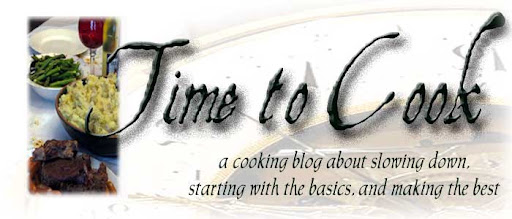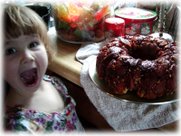My Current Obsession: The Splendid Table
 When my new iPod Touch arrived in all of its glory, one of the first things I did was take the advice of my college-age daughter--I packed my pod with podcasts from every source I could think of. One of the great gifts that fell into my favor is The Splendid Table, an American Public Media program described as "the show for people who love to eat," and indeed it is. One listen to TST and I was hooked, making my way through the archives at lightning speed while folding laundry, driving in my car, or walking on the trail. TST features fascinating segments on all things food, whether it's the locavore movement, the food scene in Moscow, eating to increase your longevity, improvising dishes, or roadside diners along The Mother Road, Route 66, the potential for learning and bringing something new and lasting to your own table is practially bottomless. Even the philosophy that comes from TST is astounding, and I often find myself nodding my head in agreement when I hear guests spouting wisdom, such as this tidbit by Neal Rosenthal, wine merchant and author of the book Reflections of a Wine Merchant:
When my new iPod Touch arrived in all of its glory, one of the first things I did was take the advice of my college-age daughter--I packed my pod with podcasts from every source I could think of. One of the great gifts that fell into my favor is The Splendid Table, an American Public Media program described as "the show for people who love to eat," and indeed it is. One listen to TST and I was hooked, making my way through the archives at lightning speed while folding laundry, driving in my car, or walking on the trail. TST features fascinating segments on all things food, whether it's the locavore movement, the food scene in Moscow, eating to increase your longevity, improvising dishes, or roadside diners along The Mother Road, Route 66, the potential for learning and bringing something new and lasting to your own table is practially bottomless. Even the philosophy that comes from TST is astounding, and I often find myself nodding my head in agreement when I hear guests spouting wisdom, such as this tidbit by Neal Rosenthal, wine merchant and author of the book Reflections of a Wine Merchant:
"We passed through a period of a decade or so where people gave up their right to choose. We became a bit slavishly entrapped in a media process which is to say that people would give over their choice of selecting to things that were praised in the press, but I sense there's a revival of all things artisan.We appreciate what values this brings to our life and our culture."This bit of wisdom was in reference to consumers' wine choices, but it could be applied to all foods. We, as an American culture, are in danger of allowing mega-stores to make our food choices for us. One look at a natural foods distributor's catalog and we begin to see what foods we're missing, what we won't find at our local Everything*Mart chain. Things like Greek yogurt, heirloom tomatoes, truly artisan breads and cheeses, high-quality baking products, fair trade chocolates and beverages are not available in these places, and if they are, their quality will likely diminish, their power to choose their growing practices decrease, and the cost of transporting will continue to rise. And once they're the only guy on the block, what they choose will become what we choose, and our local farmers, dairy producers, bakeries, winemakers, and orchards will suffer and, eventually, disappear. We will shop ourselves right out of our choices, and right out of our unique communities.
And if you think this isn't important, think about this piece of information by Dan Buetter, author of The Blue Zones, Lessons for Living Longer from the People Who've Lived the Longest, also a guest on TST.
"Food plays about 25-30% of longevity. All of the longest-living people eat mostly plants. Gardening is an ideal longevity activity because it reduces stress, uses the range of motion, and you emerge with organic vegetables. Having a sense of purpose, to know why you wake up in the morning, you're going to eat better food, exercise, and be more engaged with the world."What we choose to eat, how we grow it, how we harvest it, and how we feel about our purpose in life are three major contributors to living a long and healthy life. Do we feel a sense of purpose by buying our foods from a mega-store shelf? Do we contribute to the sense of purpose of others by purchasing items that are not fairly produced? Do we have a first-hand (literally) part in producing our own foods straight from our garden, which increases our physical health in multiple ways, from getting fresh air, gentle stretching, contact with the earth, and receiving the ultimate in fresh foods?
But there is more than food philosophy on TST. They bring practical tips to the table, too. Recipes and cooking tips abound. Just listening to charming host Lynne Rossetto Kasper's ideas on improvisation has inspired me to step outside of my cookbook-bound comfort zone to create dishes that rely on what I have in my garden and in my community. Here's a spin on Lynne's suggestion for a potted chicken, as given on the August 1st show in response to a call-in guest's request for suggestions for a braid of garlic.
Potted Chicken

1 locally-raised, free-range (preferably organic) roasting chicken
6-10 whole heads of garlic, rinsed, cut in half side-to-side (giving a cross-section look). Remove any loose papery skin, but leave heads as much intact as possible
4 large lemons
4 large onions, sliced
olive oil
kosher salt
fresh-ground pepper
fresh sprigs of rosemary
heaps of baby carrots or cleaned carrots cut into small chunks
handfuls of chunked potatoes, either Yukon Gold or red-skinned potatoes
In a dutch oven, lay the sliced onions and 4 of the cut heads of garlic. Salt and pepper the chicken very generously inside and out. Remove the rind from the lemons and cut them in half, or scoop out the lemon pulp. Stuff the chicken with the lemon pulp, several more of the heads of garlic, more onion, and then sprinkle in more salt and pepper and a few sprigs of rosemary.
Top the whole thing with as many heads of garlic, slices of onion and sprigs of rosemary as you like. Tuck as many carrots and potatoes as you would like or can fit around and on top of the chicken. Sprinkle with more salt and pepper and more rosemary sprigs. Drizzle with olive oil.
Bake, covered, in a 350 degree F oven for about 3 hours. The chicken will literally fall off of the bone. Dig the garlic heads out, scoop the buttery-soft garlic out of the skins and spread on the chicken or on pieces of crusty bread, like the No-Knead Rosemary Bread or Genovese Basil Bread. Serve the carrots and potatoes on the side. When you've finished the meal, separate the chicken from the bones and skin and use it later for delicious chicken salad. Transfer all of the garlic pulp, juices and soft onions to another container and use it for a stock base or a fabulous gravy for your next batch of mashed potatoes. If you're lucky enough to live on a farm, feed all of the bones and skin to your pig, which you'll eat later!
And be sure to check out The Splendid Table. You'll thank me.













